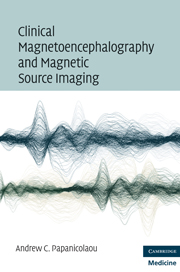Book contents
- Frontmatter
- Contents
- Contributors
- Preface
- Section 1 The method
- Section 2 Spontaneous brain activity
- Section 3 Evoked magnetic fields
- 19 Recording evoked magnetic fields (EMFs)
- 20 Somatosensory evoked fields (SEFs)
- 21 Movement-related magnetic fields (MRFs) – motor evoked fields (MEFs)
- 22 Auditory evoked magnetic fields (AEFs)
- 23 Visual evoked magnetic fields (VEFs)
- 24 Language-related brain magnetic fields (LRFs)
- 25 Alternative techniques for evoked magnetic field data – future directions
- Postscript: Future applications of clinical MEG
- References
- Index
23 - Visual evoked magnetic fields (VEFs)
from Section 3 - Evoked magnetic fields
Published online by Cambridge University Press: 01 March 2010
- Frontmatter
- Contents
- Contributors
- Preface
- Section 1 The method
- Section 2 Spontaneous brain activity
- Section 3 Evoked magnetic fields
- 19 Recording evoked magnetic fields (EMFs)
- 20 Somatosensory evoked fields (SEFs)
- 21 Movement-related magnetic fields (MRFs) – motor evoked fields (MEFs)
- 22 Auditory evoked magnetic fields (AEFs)
- 23 Visual evoked magnetic fields (VEFs)
- 24 Language-related brain magnetic fields (LRFs)
- 25 Alternative techniques for evoked magnetic field data – future directions
- Postscript: Future applications of clinical MEG
- References
- Index
Summary
Overview of VEFs
Mapping the precise location of the primary visual cortex may be indicated prior to resecting mass lesions in the vicinity of the calcarine fissure. VEFs evoked by monocular or binocular stimulation have various advantages in comparison with the visual evoked potentials (VEPs) elicited in a similar manner. Unlike VEPs, VEFs clearly and easily distinguish bilateral occipital responses from each other using left- or right-hemifield stimuli. A unilateral abnormality in the visual cortex or interhemispheric difference between the left and right cortices can, therefore, be easily and accurately detected. The intracranial sources that give rise to the early component of the magnetic waveform evoked by rapidly changing patterned stimulation are used as markers of the primary visual area. Hemifield or single-quadrant stimulation has been used successfully to localize visual cortex in patients with organic brain diseases before surgical interventions involving craniectomy and stereotactic procedures. In addition, any abnormal visual function can be quantitatively evaluated by the latency delay with or without amplitude attenuation.
Recording VEFs
VEF sources
In VEFs evoked by pattern-reversal stimulation, the responses with latency shorter than 200 ms are considered to arise from the primary visual cortex. The sources of the P100m response that peaks at approximately 100 ms after stimulus onset, which corresponds to the P100VEPresponse, is typically studied in clinical settings.
Stimulation
In a typical recording session, stimuli consist of half-field checkerboard patterns subtending 30 degrees of visual angle, changing every 1 sec (second) to introduce a complete local brightness reversal while maintaining a constant average luminance. A trigger is generated every time a reversal takes place. Approximately 200 such reversals are presented.
- Type
- Chapter
- Information
- Clinical Magnetoencephalography and Magnetic Source Imaging , pp. 138 - 143Publisher: Cambridge University PressPrint publication year: 2009



